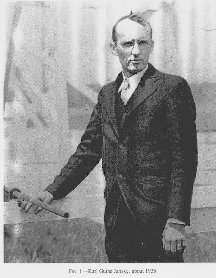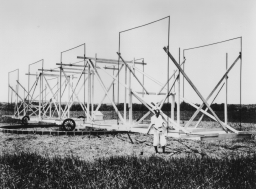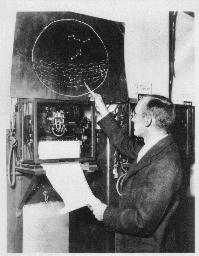Karl Jansky and the Discovery of Cosmic Radio Waves |
Versión en Español |
 Karl Guthe Jansky was born in Norman Oklahoma October 22, 1905 (d.Feb.14, 1950),
graduated with a degree in physics from the University of Wisconsin, and
joined the staff of the Bell Telephone Laboratories in Holmdel, NJ,
in 1928.
Karl Guthe Jansky was born in Norman Oklahoma October 22, 1905 (d.Feb.14, 1950),
graduated with a degree in physics from the University of Wisconsin, and
joined the staff of the Bell Telephone Laboratories in Holmdel, NJ,
in 1928.
Bell Labs wanted to investigate using "short waves" (wavelengths of about 10-20 meters) for transatlantic radio telephone service. Jansky was assigned the job of investigating the sources of static that might interfere with radio voice transmissions.
 He built an antenna, pictured here, designed to receive radio waves at a
frequency of 20.5 MHz (wavelength about 14.5 meters). It was mounted on
a turntable that allowed it to rotate in any direction, earning it the name
"Jansky's merry-go-round". By rotating the antenna, one could find
what the direction was to any radio signal.
He built an antenna, pictured here, designed to receive radio waves at a
frequency of 20.5 MHz (wavelength about 14.5 meters). It was mounted on
a turntable that allowed it to rotate in any direction, earning it the name
"Jansky's merry-go-round". By rotating the antenna, one could find
what the direction was to any radio signal.
After recording signals from all directions for several months, Jansky identified three types of static:
1. nearby thunderstorms, 2. distant thunderstorms, and 3. a faint steady hiss of unknown origin. Jansky spent over a year investigating the third type of static. It rose and fell once a day, leading Jansky to think at first that he was seeing radiation from the Sun.
But after a few months of following the signal, the brightest point moved away from the position of the Sun. The signal repeated not every 24 hours, but every 23 hours and 56 minutes. This is characteristic of the fixed stars, and other objects far from our solar system. He eventually figured out that the radiation was coming from the Milky Way and was strongest in the direction of the center of our Milky Way galaxy, in the constellation of Sagittarius.
The discovery was widely publicized, appearing in the New York Times of May
5, 1933.

Jansky wanted to follow up on this discovery and investigate the radio waves from the Milky Way Galaxy in more detail. He proposed to Bell Labs to build a 100 foot (30 meter) diameter dish antenna. But Bell Labs had the answer they wanted about static: the static was not a problem for transatlantic radio communication. Jansky was assigned to another project and did no more radio astronomy.
Many scientists were fascinated by Jansky's discovery, but no one followed
up on it for several years. It was during the great depression, and
observatories could not afford take on any new projects.
Two men who learned of Jansky's discovery in 1933 were of great influence on the later development of the new study of radio astronomy: one was Grote Reber, who singlehandedly built a radio telescope in his back yard in 1937 and did the first systematic survey of radio waves from the sky. The second was John Kraus, who, after World War II, started a radio observatory at Ohio State University and wrote a textbook on radio astronomy, which is still the "bible" for radio astronomers.
Jansky's role as the "Father of Radio Astronomy" is commemorated in various ways:
- The National Radio Astronomy Observatory awards an annual
Jansky Prize Lectureship.
The winner for the year 2000 was V. Radhakrishnan.
The winner for 2002 is Shrinivas Kulkarni. - Bell Labs built a
monument for Karl Jansky in the form of a scale model of his antenna.
- At NRAO-Green Bank, the main lab and office building is named the Jansky Laboratory.
- He is also commemorated at NRAO-Green Bank with a full-scale replica of his antenna.
- Last but not least, the unit of apparent brightness used by radio astronomers
is named after him:
one Jansky is a flux density of
10-26 Watts / m2 / Hertz.
Publications by Karl G. Jansky
- 1932: "Directional studies of atmospherics at high frequencies", Proc.IRE, 20, p.1920.
- 1933: "Electrical disturbances apparently of extraterrestrial origin", Proc.IRE, 21, p.1387.
- 1933: "Radio waves from outside the solar system", Nature, 132, p66.
- 1933: "Electrical phenomena that apparently are of interstellar origin", Popular Astronomy, 41, p.548, Dec.1933.
- 1935: "A note on the source of interstellar interference", Proc.IRE, 23, p1158.
- 1937: "Minimum noise levels obtained on short-wave radio receiving systems", Proc.IRE, 25, p1517.
Note: many of these early papers have been re-printed in "Classics in Radio Astronomy", by W.T.Sullivan, published by Cambridge University Press, 1982
by C. M. Jansky, Jr. (Karl's brother)
- 1957: "The beginnings of radio astronomy", Amer.Scientist, 45, p5.
- 1958: "The discovery and identification by Karl Guthe Jansky of electromagnetic radiation of extraterrestrial origin in the radio spectrum", ProcIRE, 46, p13, January 1958.
- 1984: Paper in Serendipitous Discoveries in Radio Astronomy, ed.Kellermann and Sheets, Proc.NRAO Workshop no.7. (Green Bank, WV, May 1983). Pub.by NRAO, 1984.
